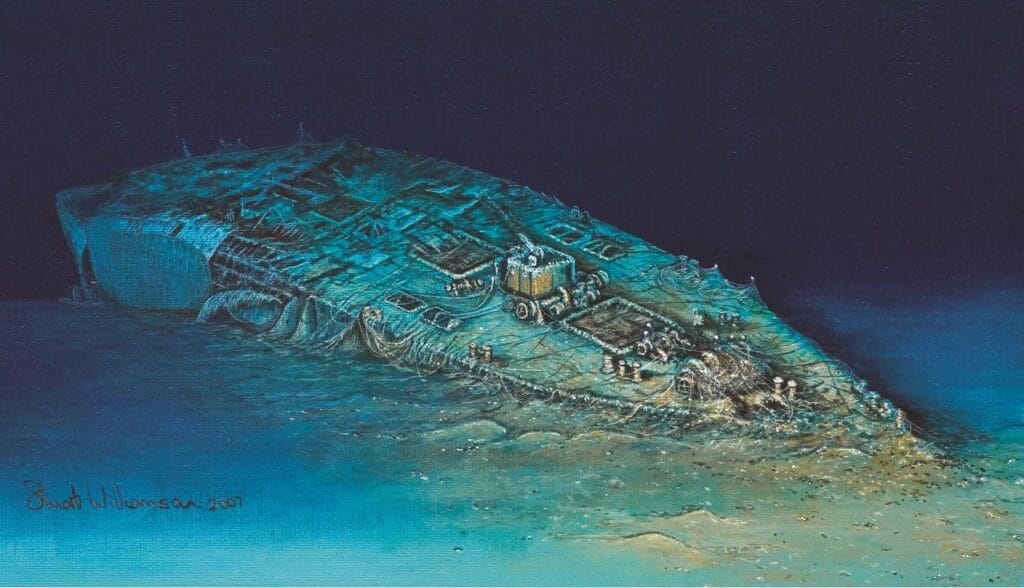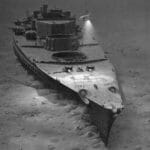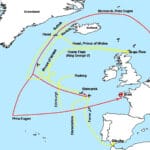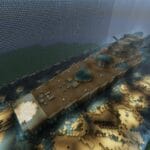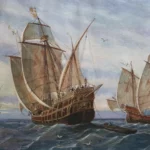Get ready to dive into the thrilling tale of the RMS Carpathia, a ship that played a pivotal role in the tragedy of the Titanic. This heroic vessel met its own watery end during World War I. Its wreckage, resting deep in the Atlantic, tells a chilling story of bravery and loss. Join us on this journey to uncover the fascinating story of the RMS Carpathia, from its noble beginnings to its haunting underwater fate.
Carpathia’s Demise: A Titanic Hero Meets Tragedy
The RMS Carpathia, a name forever linked with the Titanic, rests on the ocean floor, a silent witness to history. While the Titanic’s story continues to captivate, the Carpathia’s own dramatic journey and eventual fate deserve to be remembered and understood.
A Beacon of Hope in the Night
When the Titanic sent out its desperate distress signal in 1912, the Carpathia raced through the icy waters of the North Atlantic. Captain Arthur Rostron, displaying incredible seamanship and courage, navigated through dangerous ice fields, ultimately bringing aboard over 700 survivors. This heroic rescue mission cemented the Carpathia’s place in maritime history, not as a victim of the sea, but as a symbol of hope and resilience.
From Rescue to War: A Fateful Transition
The Carpathia’s story didn’t end with the Titanic. As World War I engulfed Europe, the ship transitioned from a transatlantic liner to a troop transport. On a fateful day in July 1918, a German U-boat torpedoed the Carpathia off the coast of Ireland. While many survived thanks to the rescue efforts of HMS Snowdrop, the attack tragically claimed the lives of five crew members.
Finding the Carpathia: A Lost Ship Remembered
For decades, the Carpathia lay forgotten on the seabed. Then, in 2000, a team led by the renowned underwater explorer Clive Cussler and his organization NUMA discovered the wreck. The ship, resting at a depth of over 500 feet, bore the marks of both the torpedo attack and the relentless passage of time. Despite the challenges, the discovery opened a window into a pivotal moment in history.
Unlocking the Secrets of the Deep: A Time Capsule of History
The wreck of the Carpathia is more than just a collection of rusted hull plates and scattered artifacts. It represents a tangible link to a bygone era, offering valuable insights into early 20th-century shipbuilding techniques, the lives of the crew who sailed on her, and the events surrounding her sinking.
Some experts believe the wreck may hold clues about the effectiveness of wartime torpedo technology, while others are interested in studying the ship’s rate of deterioration in deep-sea environments. Every piece of data recovered from the site helps paint a richer picture of the Carpathia’s story. It’s also worth noting that the wreck lies amidst a scattering of ammunition, both from the Carpathia herself and the HMS Snowdrop. These remnants of war underscore the tragic circumstances of her sinking.
A Legacy Worth Preserving: Honoring the Carpathia
While the Titanic’s memory continues to loom large, the Carpathia’s own remarkable story, from its heroic actions to its wartime service and tragic sinking, deserves to be remembered and honored.
The wreck site, though deep and challenging to access, holds immense historical and archaeological value. Efforts to document the site, recover artifacts, and preserve its memory are crucial for ensuring that the Carpathia’s legacy, along with the stories of those who sailed on her, continues to resonate with future generations.
Has the Carpathia Wreck Been Found? Unraveling a Maritime Mystery
The Carpathia isn’t just known for its heroic actions; sadly, it faced a tragic ending, too. After its famed rescue of Titanic survivors, it was pressed into service during World War I. During this time, while transporting troops, a German submarine torpedoed it on July 17, 1918. Five crew members tragically lost their lives that day, but thankfully, the HMS Snowdrop was able to rescue the remaining 218.
For the longest time, the precise location where the Carpathia sank was lost to time. It became an intriguing ocean mystery. That’s when NUMA, the National Underwater and Marine Agency (led by the famous Clive Cussler!), stepped in. They started a search expedition in 1999, but it wasn’t straightforward. They initially thought they found it, but it turned out to be a case of mistaken identity – another shipwreck entirely. Finally, in May 2000, they were able to confirm its location using advanced technology like side-scan sonar and ROV footage.
So, where is the Carpathia now? The Carpathia rests 120 miles south of Fastnet, Ireland, lying 514 feet underwater. This depth makes exploring it quite challenging, but even so, it’s treated with a great deal of respect, much like a war grave.
The story of the Carpathia is bittersweet. On one hand, it’s known for its amazing courage during the Titanic disaster, a symbol of hope in a terrible tragedy. But on the other hand, its own sinking reminds us that even the strongest ships are vulnerable to the power of the sea and the events of war.
Finding the Carpathia is more than just finding an old shipwreck. It gives us a way to connect with maritime history, to remember the brave people who were part of its story, and to understand the triumphs and tragedies that have shaped our relationship with the sea.
How Was the Carpathia Sunk? From Hero to Casualty of War
The RMS Carpathia, forever known for bravely rescuing survivors from the Titanic, met a dramatic fate amidst the chaos of World War I. But how did this vessel, forever linked to one maritime disaster, become part of another?
In 1915, with war raging, ships like the Carpathia weren’t just carrying eager travelers. They were pressed into service as troop transports, essential for moving soldiers and vital supplies. This put the Carpathia directly in harm’s way.
On July 17, 1918, the Carpathia was sailing off the southern coast of Ireland. The seas, however, weren’t friendly. Lurking beneath the waves was the German submarine U-55, a silent predator in the vast Atlantic.
The U-55, spotting the Carpathia, launched not one, but three torpedoes. These underwater missiles, carrying devastating explosive power, found their mark. While we can’t know for certain how quickly the Carpathia went down, the damage inflicted by three torpedoes suggests a catastrophic event.
Remarkably, amidst the tragedy, a glimmer of hope emerged. The British destroyer HMS Snowdrop, likely patrolling nearby, arrived on the scene just in time. This swift response meant the vast majority of those aboard the Carpathia were safely rescued, a testament to the bravery and efficiency of the Snowdrop’s crew.
However, the attack wasn’t without casualties. Five crew members of the Carpathia tragically lost their lives that day, serving as a somber reminder of the human cost of war, even far from the battlefields.
Today, the wreck of the Carpathia rests on the ocean floor, a silent witness to history. It serves as a poignant symbol of the ship’s dual legacy – first, as a beacon of hope during the Titanic disaster and later, as a casualty of the global conflict that engulfed the world.
How Deep is the Carpathia Shipwreck? Exploring the Depths of History
We know the RMS Carpathia for its heroic actions – rescuing over 700 survivors from the Titanic. Today, this famous ship rests on the ocean floor, about 120 miles south of Fastnet, Ireland. But how deep is it? The Carpathia lies at a depth of 500 feet (or 152 meters). To put that into perspective, imagine stacking the Statue of Liberty underwater – the Carpathia would be even deeper!
This depth, combined with its remote location in the vast Atlantic, makes exploring the wreckage a real challenge. It wasn’t until the year 2000 that Clive Cussler and his team at the National Underwater and Marine Agency (NUMA) were able to locate it. They used advanced sonar technology, essentially “seeing” with sound waves to find the ship hidden beneath the waves.
The Carpathia’s resting place is a poignant reminder of its past. It’s a place where history seems frozen in time. It’s not just a sunken ship; it’s a time capsule holding artifacts and stories from both the Titanic rescue and its own sinking during World War I.
The Carpathia’s story continues to fascinate people. Its depth and location make studying it difficult, but that hasn’t stopped researchers from wanting to learn more about this important vessel.
Can You Visit the Carpathia? A Journey to the Depths of History
The RMS Carpathia, eternally linked to the Titanic for its heroic rescue mission, rests at the bottom of the Atlantic Ocean, approximately 120 miles south of Fastnet, Ireland. While its story continues to captivate, the question arises: Can you visit the Carpathia?
The answer is a complex one. Unlike the numerous museums and memorials dedicated to the Titanic, the Carpathia itself lies at a depth of 500 feet (152 meters), making it inaccessible to all but the most experienced technical divers. Factors like frigid water temperatures, potential hazards from scattered ammunition, and legal restrictions imposed by RMS Titanic Inc., the wreck’s owner, further complicate exploration efforts.
While the Carpathia’s depth may deter casual visitation, it also serves as a shield, protecting this historical treasure from the elements and inadvertent damage. The deep-sea environment, though harsh, has acted as a preservative, keeping the Carpathia’s story largely intact.
For those unable to make the dive themselves, technology offers a window into this underwater world. High-resolution sonar imaging and ROV footage, captured during expeditions led by organizations like NUMA, provide glimpses into the Carpathia’s current state. These images reveal a wreck both hauntingly beautiful and undeniably moving.
Furthermore, museums and maritime historical societies around the world house artifacts recovered from the Carpathia. These tangible pieces of history, ranging from navigational equipment to personal belongings of the crew, offer a poignant connection to the ship’s past.
While a physical visit to the Carpathia remains a logistical and ethical challenge, the opportunity to explore its story is far from lost. Through technological advancements, historical archives, and the tireless efforts of researchers and enthusiasts, the legacy of the Carpathia, the “Ship That Didn’t Sink,” continues to surface, reminding us of the courage, sacrifice, and enduring power of hope that connect us all.
Other Historical Figures and Events:
There’s a lot of history to be found in the big seas. One of the most famous battleships from the Japanese Imperial Navy was the japanese battleship musashi. And if you are interested in popes, did you know that there were five popes who each chose the same name? You can learn about them here.
